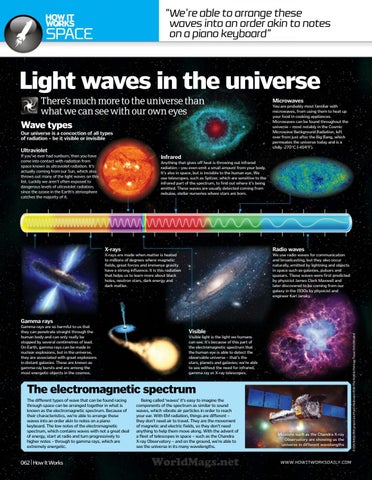“We’re able to arrange these waves into an order akin to notes on a piano keyboard”
SPACEWorldMags.net
Light waves in the universe There’s much more to the universe than what we can see with our own eyes Wave types Our universe is a concoction of all types of radiation – be it visible or invisible
Ultraviolet If you’ve ever had sunburn, then you have come into contact with radiation from space known as ultraviolet radiation. It’s actually coming from our Sun, which also throws out many of the light waves on this list. Luckily we aren’t often exposed to dangerous levels of ultraviolet radiation, since the ozone in the Earth’s atmosphere catches the majority of it.
Microwaves You are probably most familiar with microwaves, from using them to heat up your food in cooking appliances. Microwaves can be found throughout the universe – most notably in the Cosmic Microwave Background Radiation, left over from just after the Big Bang, which permeates the universe today and is a chilly -270°C (-454°F).
Infrared Anything that gives off heat is throwing out infrared radiation – you even emit a small amount from your body. It’s also in space, but is invisible to the human eye. We use telescopes, such as Spitzer, which are sensitive to the infrared part of the spectrum, to find out where it’s being emitted. These waves are usually detected coming from nebulae, stellar nurseries where stars are born.
X-rays
Radio waves
X-rays are made when matter is heated to millions of degrees where magnetic fields, great forces and immense gravity have a strong influence. It is this radiation that helps us to learn more about black holes, neutron stars, dark energy and dark matter.
We use radio waves for communication and broadcasting, but they also occur naturally, emitted by lightning and objects in space such as galaxies, pulsars and quasars. These waves were first predicted by physicist James Clerk Maxwell and later discovered to be coming from our galaxy in the 1930s by physicist and engineer Karl Jansky.
Gamma rays are so harmful to us that they can penetrate straight through the human body and can only really be stopped by several centimetres of lead. On Earth, gamma rays can be made in nuclear explosions, but in the universe, they are associated with great explosions in distant galaxies. These are known as gamma-ray bursts and are among the most energetic objects in the cosmos.
Visible Visible light is the light we humans can see. It’s because of this part of the electromagnetic spectrum that the human eye is able to detect the observable universe – that’s the stars, planets and galaxies; we’re able to see without the need for infrared, gamma ray or X-ray telescopes.
The electromagnetic spectrum The different types of wave that can be found racing through space can be arranged together in what is known as the electromagnetic spectrum. Because of their characteristics, we’re able to arrange these waves into an order akin to notes on a piano keyboard. The low notes of the electromagnetic spectrum, which contains waves with not a great deal of energy, start at radio and turn progressively to higher notes – through to gamma rays, which are extremely energetic.
062 | How It Works
Being called ‘waves’ it’s easy to imagine the components of the spectrum as similar to sound waves, which vibrate air particles in order to reach your ear. With EM radiation, things are different – they don’t need air to travel. They are the movement of magnetic and electric fields, so they don’t need anything to help them move along. With the advent of a fleet of telescopes in space – such as the Chandra X-ray Observatory – and on the ground, we’re able to see the universe in its many wavelengths.
WorldMags.net
Missions such as the Chandra X-ray Observatory are showing us the universe in different wavelengths
WWW.HOWITWORKSDAILY.COM
© ESA/NASA/AVO project and Paolo Padovani//ESA/The Hubble Heritage Team/ Felix Mirabel
Gamma rays




